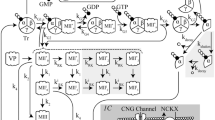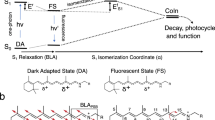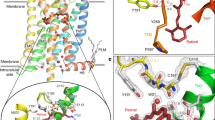Abstract
FOR the dark-adapted human observer, the absolute visual threshold has been estimated to be the effective absorption of 5–10 photons in an area covered by some 500 rods1. Although the quantum statistics of light enter as a factor which determines the frequency of seeing weak light stimuli1,2, it has been suggested that there is ‘noise’ in the visual system which ultimately limits the sensitivity of the eye3,4. Each rod in the human eye contains about 108 rhodopsin molecules, and if the ‘noise’ arises from events in the rod indistinguishable from the effects of light, there must be an extremely low probability of spontaneous change produced in any single rhodopsin molecule (or at sites within the rod disk membrane leading to an elementary voltage change in the rod). We have analysed voltage fluctuations in bipolar cells as a probe of rod activity in the dogfish retina. A component of the noise has been identified as photon noise, superimposed on dark noise arising from photon-like events. This part of the dark noise has a large temperature dependence (Q10 about 8), suggesting thermal isomerisation of rhodopsin. The rate constant, extrapolated to 37 °C, would correspond to one isomerisation in 30 s in a human rod, similar to estimates from the absolute threshold for human vision.
This is a preview of subscription content, access via your institution
Access options
Subscribe to this journal
Receive 51 print issues and online access
$199.00 per year
only $3.90 per issue
Buy this article
- Purchase on Springer Link
- Instant access to full article PDF
Prices may be subject to local taxes which are calculated during checkout
Similar content being viewed by others
References
Hecht, S., Shlaer, S. & Pirenne, M. H. J. gen. Physiol. 25, 819–840 (1942).
Rose, A. J. opt. Soc. Am. 38, 196–208 (1948).
Denton, E. J. & Pirenne, M. H. J. Physiol., Lond. 123, 417–442 (1954).
Barlow, H. B. J. opt. Soc. Am. 46, 634–639 (1956).
Ashmore, J. F. & Falk, G. J. Physiol., Lond. 258, 39–40P (1976).
Ashmore, J. F. & Falk, G. Nature, 263, 248–249 (1976).
Ashmore, J. F. & Falk, G. J. Physiol., Lond. 269, 27–28P (1977).
Baylor, D. A., Hodgkin, A. L. & Lamb, T. D. J. Physiol., Lond. 242, 685–727 (1974).
Penn, R. D. & Hagins, W. A. Biophys. J. 12, 1073–1094 (1972).
Hubbard, R. J. gen. Physiol. 42, 259–280 (1958).
Hubbard, R. & Kropf, A. Proc. natn. Acad. Sci. U.S.A. 44, 130–139 (1958).
Glasstone, S., Laidler, K. J. & Eyring, H. The Theory of Rate Processes (McGraw Hill, New York, 1941).
Hubbard, R. J. biol. Chem. 241, 1814–1818 (1966).
St George, R. C. C. J. gen. Physiol. 35, 495–517 (1952).
Dartnall, H. J. A. The Visual Pigments (Methuen, London, 1957).
Stiles, W. S. in Transactions of the Optical Convention of the Worshipful Company of Spectacle Makers 97–107 (Spectacle Makers' Company, London, 1948).
Denton, E. J. & Pirenne, M. H. J. Physiol., Lond. 125, 181–207 (1954).
de Vries, H. Progr. Biophys. biophys. Chem. 6, 207–264 (1955).
Falk, G. & Fatt, P. in Handbook of Sensory Physiology 7 (ed. Dartnall, H. J. A.) 200–244 (Springer, Heidelberg, 1972).
Simon, E. J., Lamb, T. D. & Hodgkin, A. L. Nature, 256, 661–662 (1975).
Simon, E. J. & Lamb, T. D. in Vertebrate Photoreception (ed. Barlow, H. B. & Fatt, P.) (Academic, London, in the press).
Schwartz, E. A. in Vertebrate Photoreception (ed. Barlow, H. B. & Fatt, P.) (Academic, London, in the press).
Author information
Authors and Affiliations
Rights and permissions
About this article
Cite this article
ASHMORE, J., FALK, G. Dark noise in retinal bipolar cells and stability of rhodopsin in rods. Nature 270, 69–71 (1977). https://doi.org/10.1038/270069a0
Received:
Accepted:
Issue Date:
DOI: https://doi.org/10.1038/270069a0
This article is cited by
-
Temperature stabilizing effect of tocopherol on rhodopsin in the pressure of fatty acids studied by differential scanning calorimetry
Bulletin of Experimental Biology and Medicine (1989)
-
Low retinal noise in animals with low body temperature allows high visual sensitivity
Nature (1988)
-
Photoenergetics of octopus rhodopsin
European Biophysics Journal (1986)
-
Photon-like signals following weak rhodopsin bleaches
Nature (1981)
-
Different postsynaptic events in two types of retinal bipolar cell
Nature (1980)
Comments
By submitting a comment you agree to abide by our Terms and Community Guidelines. If you find something abusive or that does not comply with our terms or guidelines please flag it as inappropriate.



